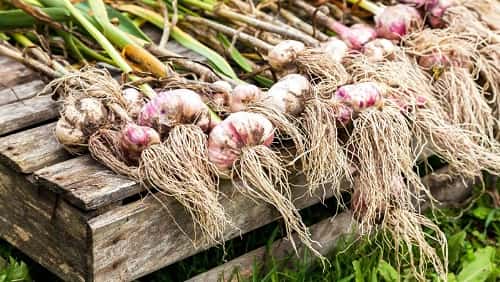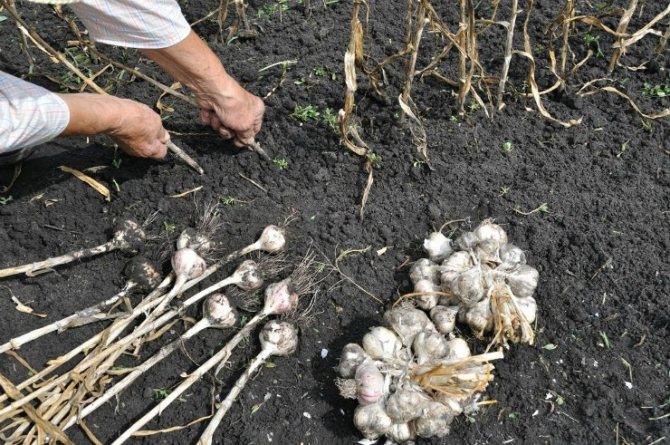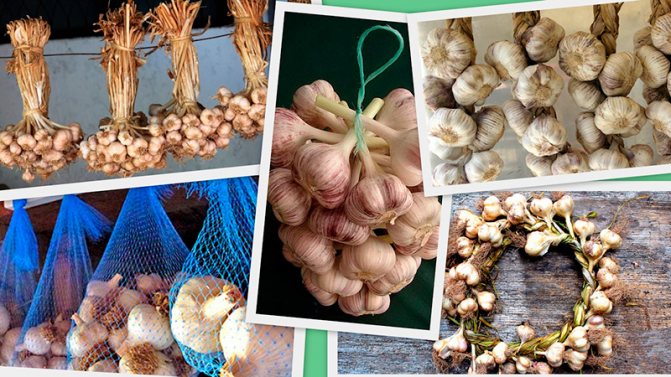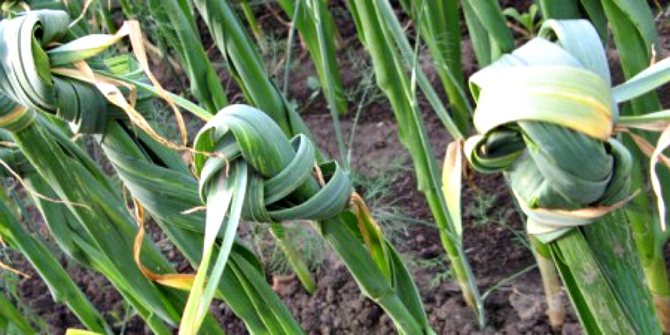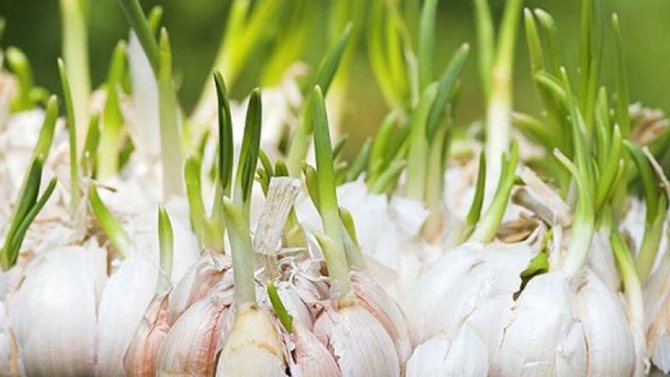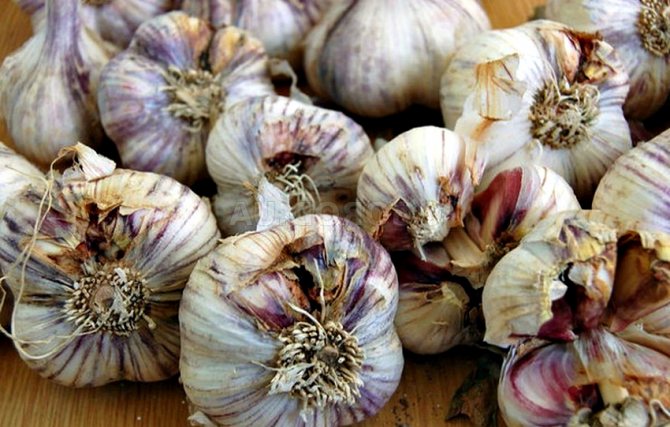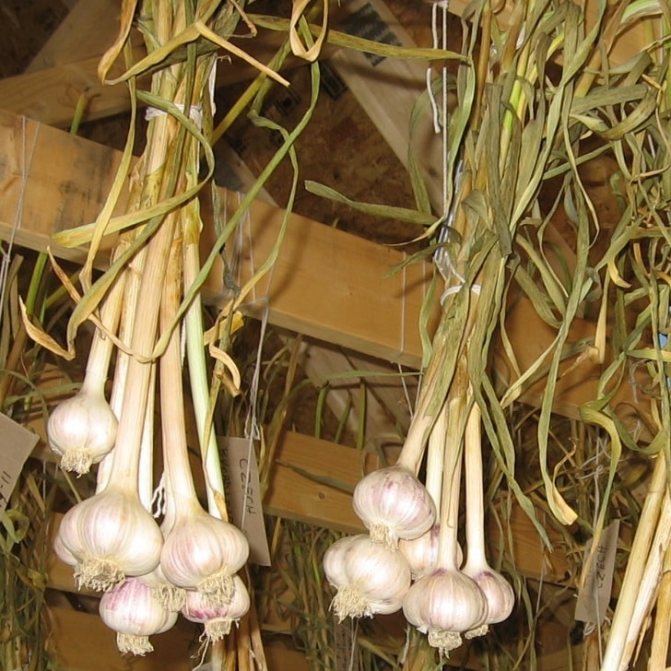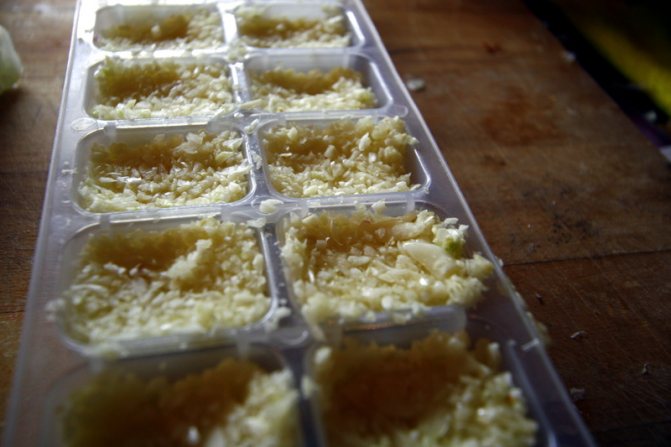21.04.201721.04.2017 Maria Ivanova 1 Comment
We all know what garlic is. Everyone knows about its beneficial properties and how it transforms the taste characteristics of almost any dish.
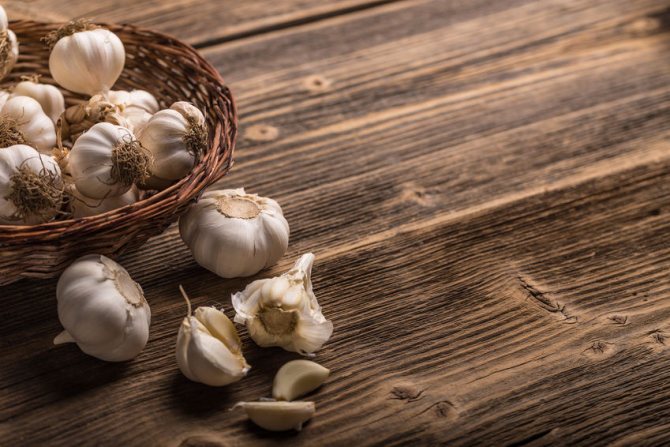
But not everyone knows how to properly store garlic so as not to lose their harvest and money spent. Subject to all conditions, this vegetable can keep a good appearance for a long time and not spoil.
We clean up on time
The shelf life is influenced by the timeliness of the harvest. The harvesting period depends on the type of garlic. A spring, non-shooting species can be harvested after yellowing and lodging of foliage. Typically, this period occurs in the last 2 weeks of summer.
Young winter garlic is harvested at the end of July. A sufficient degree of maturation can be determined by the following external signs:
- the skin on the inflorescences cracks;
- the lower row of leaves becomes yellow;
- the scales of the bulbs are dry.
Harvesting is recommended in dry and warm weather. Violation of the cleaning rules can lead to a deterioration in quality and presentation.
Preservation conditions
Dug up the garlic in time. If you overexpose it in the ground or, conversely, dig it up too early, it will reduce its shelf life. If the lower leaves of the stem dry up, and the released arrow straightens completely, then it's time to harvest. Sometimes you may notice that the peel on the arrow has burst - this is also a sign that the garlic is ready to dig out. If the arrow is bent, it is too early to dig.
Store garlic in a dark cool room at temperatures up to 15 degrees and in the absence of high humidity. Too dry air negatively affects the product - garlic dries out faster.
You need to sort out the garlic. Only a healthy product can be stored for a long time.
Remove heads with dark spots or soft to the touch. They will infect a healthy crop.
The shelf life also depends on the type of garlic. Some varieties will not lie until spring, no matter how carefully they are protected.
Preparing the bulb for storage
Proper preparation of the harvested crop for storage will extend the shelf life. The preparation process requires pruning the heads of garlic, drying and sorting into varieties.
Stem and roots - leave or not?
Sharpened garden shears are used to trim the garlic. Roots about 3 mm long are left on each head. Then the stems are pruned, leaving no more than 10 cm. Proper pruning promotes storage throughout the winter period. In addition, crop pruning has a number of additional benefits, including the following:
- convenient storage in a compact form;
- trimmed specimens do not soften or deteriorate;
- cut winter garlic retains its characteristics for 3-4 months after harvest, and spring garlic - until the new harvest ripens.


In what container
Before placing the garlic in a container, burn the roots over a gas burner or candle. This will prevent bacteria and fungi from entering through the root system and the product will be better preserved.
Box
For storage, use ventilated containers: cardboard boxes, wooden boxes with slots or plastic ones with a lattice. We fill the containers to the top and leave them in a cool, dark place.It is possible on the balcony or attic, but in severe frosts, the boxes must be covered with old blankets, down jackets, coats, or brought into the apartment or house during the cold snap.
Eat garlic in winter to prevent colds?
Basket
The heads are folded into wicker baskets that allow air to pass through and "breathe". The container is removed to the basement, balcony or closet.
Bag
The bag should be linen so that it can freely let air through. For better preservation, you can put dried nettle leaves there. It will kill bacteria and keep the garlic from spoiling for a long time. The bag needs to be tied. Go through the contents of the bags periodically. Throw out the heads that have begun to deteriorate.
Grid
Fold the garlic into a net and hang. This method is convenient because the heads are well ventilated. They are also perfectly visible in the net, so the hostess will easily notice which head has started to deteriorate and will remove it.
Stockings or tights
Dried garlic is placed in nylon tights and hung from doors, ceilings or beams. This method is similar to grid storage.
Banks
Put the garlic in glass jars and leave in a cool place. You cannot cover the jars with lids, otherwise the garlic will rot.
Without container
Outdoor storage methods without containers are common and convenient. Air is supplied to each head, and the garlic stays fresh longer. In addition, each head is visible, so the hostesses can control the storage process. If the head deteriorates, it can be cut off.
In braids
Garlic "pigtail" looks very nice in the kitchen. You can store such a bundle in a barn, where it is dry and cool. Garlic harvested in this way takes up little space.
For the "pigtail" on the blanks, we leave a stem about 20 centimeters long. Before starting work, we knead it with our hands so that it bends well. You will also need a long string or string to secure it.
We tie the three heads together, and then we begin to weave the braid, like on hair. Weave the rope together with the stems. Add new heads in one row.
Cracked heads can also be woven into the bundle, since garlic from the "pigtail" is used first of all.
It dries faster outdoors than in a box. Whenever you need garlic, just cut off the head. Tie the remaining stems with a loose piece of rope or cord.
You can hang such a "pigtail" in the kitchen on the door, above the cabinets or in the corner.
In bunches
This method is similar to storing garlic in a pigtail, but easier and faster. We tie the garlic heads together ten pieces by the stems and hang them in the kitchen.
We dry properly
After removing the garlic from the ground, it is necessary to shake off the soil from it and spread it out to dry on the surface of the beds. The process will take about 4-5 days. If rainfall or damp weather is observed, it is recommended to harvest the crop in a well-ventilated area. It is necessary to dry the heads together with the leaves.
See also
How to properly store fresh cucumbers at home longer
Separating varieties
Since different types of garlic differ in storage time, the winter and summer varieties must be separated from each other. Spring varieties of garlic have a higher keeping quality, and winter crops are less suitable for long-term storage in winter. The latter have risks of drying out in case of insufficient moisture, mold and decay. This is explained by the smaller number of protective scales in comparison with spring varieties.
The main part of winter varieties is recommended to be planted in autumn to ripen an early harvest in the next season.
Sorting
The entire harvested crop must be carefully examined for further sorting.Damaged, deformed and cracked heads are not suitable for long-term storage. If rotted and deformed specimens are left next to the rest of the crop, the likelihood of deterioration in taste and the spread of rot increases.


Types of garlic and popular varieties
There are 2 types of garlic: spring or summer and winter or winter. If the garlic is planted in spring, and the harvest is harvested in the second half of summer, then this is a summer type of garlic. It has many teeth, which are located in several rows, does not have a stem, does not form an arrow. Spring garlic is stored better than winter garlic.
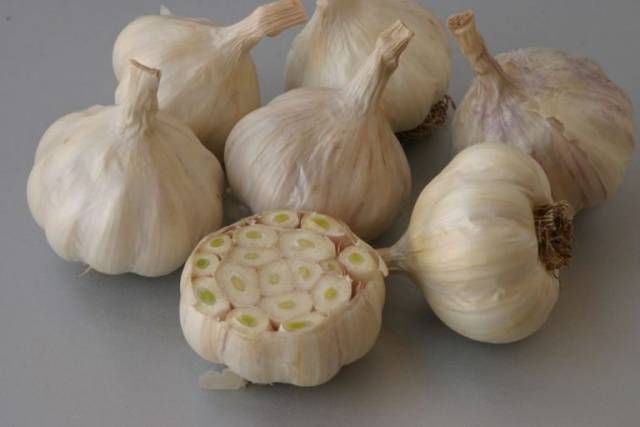

Winter garlic is planted in the fall, shortly before the onset of cold weather, garlic has time to build up the root system and so goes into winter. In the spring it starts to grow. The crop is harvested in late July - early August. Winter garlic forms 3 to 6 cloves, and they are very large and have a pungent taste. They are arranged around the stem in one row.


The most reliable varieties of summer garlic suitable for storage are distinguished:
- Abrek is a mid-season variety, white teeth, dense, spicy taste. It is very well stored and gives high yields, the bulb weighs up to 45 g;
- Sochi-56 is a rapidly ripening variety, resistant to climatic extremes, viruses, fungi. The bulb weighs approximately 45 g;
- Ershovsky is a mid-season variety, has a high degree of preservation, can be stored for more than six months, the bulb is round, slightly flattened, its weight is 40 g, the taste is medium spicy;
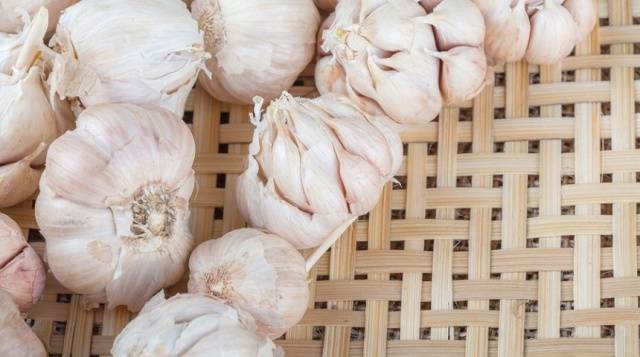

- Porechye - has a rounded, slightly flattened onion with white scales, its weight is 25 g, it is stored for more than 7 months;
- Aleyskiy is a mid-season variety, bred for the West Siberian region, suitable for growing in other regions, bulb weight no more than 25 g. Resistant to diseases and temperature fluctuations.
Important! Garlic is a crop that does not tolerate changes in climatic conditions of growth. It is not advisable to plant garlic grown in other countries. Use local varieties that are just as good as varietals.
Proven winter varieties that keep well:
- Gulliver is a medium late variety, can form a bulb up to a quarter of a kilogram. Prefers loose, well-drained soils. On dense soils, yield drops. Possesses a high degree of preservation;


- Lyubasha is a medium late variety, forms an abundant green mass, up to 1.5 m high, the bulb has slightly pink scales, its weight can reach 125 g, the variety is well stored, has a high yield;
- Losevsky is a mid-season variety, ripens for about 110 days, the taste is medium-sharp, it is well stored and has a yield of up to 2.5 kg per 1 sq. m, bulb weight up to 75 g;
- Podmoskovny - mid-season variety, with a fairly strong pungency, head weight up to 60 g, number of cloves - 6-7, from 1 sq. m you can get 2 kg of bulbs;
- Dobrynya is a late variety, stored for up to six months, head weight up to 60 g, tolerates winter well, is resistant to diseases, yield more than 2 kg per 1 sq. m.
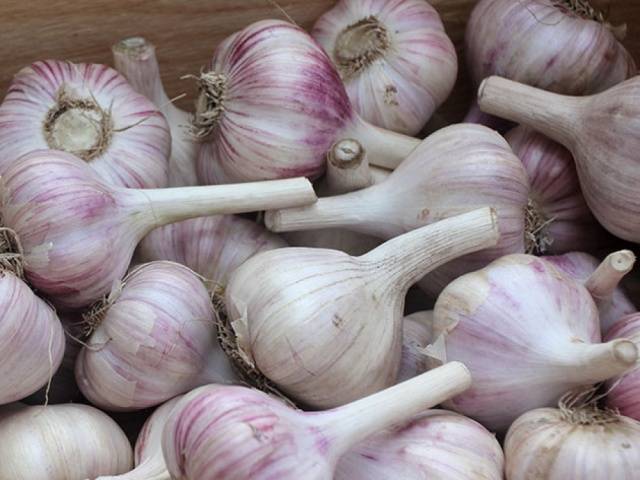

As a rule, winter varieties of garlic have a sharper taste than summer varieties, but they are much better stored.
Optimal conditions for long-term lying of garlic
When storing at home, it is important to create a favorable microclimate. Environmental conditions directly affect the maximum shelf life of the harvested crop, its flavor characteristics and presentation.
Humidity
A suitable indicator of humidity varies widely - from 50 to 80%. Higher humidity can provoke crop rot, while a lower humidity can dry out the cloves.
Temperature
Garlic is considered unpretentious to the ambient temperature, so it can be stored both warm and cold. However, there are small restrictions:
- Leaving the crop warm, it is recommended to ensure the temperature is within 15-20 degrees. It is better to store spring varieties at this temperature.
- When in the cold, the optimum temperature is 2-4 degrees. This regime is favorable for winter species.
It is also important to avoid sudden changes in temperature. Changing conditions negatively affects taste.


Airing
The room in which supplies are left for the winter should be periodically ventilated. The fresh air supply prevents the development of mold and harmful microorganisms. It is also recommended to make small openings in storage containers for constant air circulation.
Shine
Semi-dark places are ideal for storing crops. It is necessary to limit direct sunlight on the fruits so that they remain fresh and rich in taste for a long period.
General recommendations
For garlic to be stored for a long time, it is important to fulfill the following conditions:
- choose a varietybelonging to the category of bedridden;
- process the teeth before planting drugs that protect against pests and diseases;
- in the process of growing in the strictest manner comply with all agrotechnical standards (watering, fertilizing, removing weak and diseased plants, etc.);
- carefully before storing dry and sort heads;
- comply with all storage rules.
Garlic stores well at home, but it is important to provide optimal conditions for this. At what temperature should the crop be stored? At + 15… 20 ℃ when choosing a warm storage method and at + 2… 4 ℃ when keeping in the cold.
Creating favorable storage conditions will help preserve the juiciness, aroma and useful properties of the product.
It is also important to monitor the humidity of the air. In the storage area, it should not be too low so that the garlic does not dry out, or high, otherwise the crop will quickly rot. To prevent the germination of garlic, the moisture content should be within 50%.
Storing the heads of garlic in the refrigerator is completely pointless (the humidity there is always much higher than necessary).
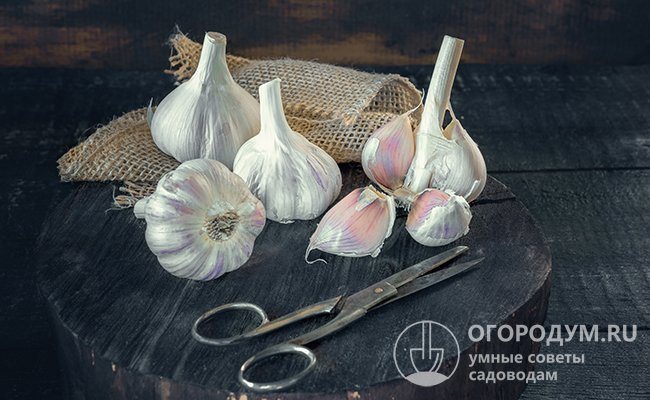

Trim the roots and stems before storing the garlic. This will reduce the risk of rotting and sprouting, which will save vegetables until spring.
Ways to save garlic for the winter
The harvested garlic can lie until spring when stored in a variety of ways. Depending on your own preferences and capabilities, you can choose the most appropriate one.
See also
How and how much you can store raspberries at home, the best ways
In a cellar or basement
Temperature conditions, humidity and lighting in basements and cellars are fully suitable for the onion family. There are several options for storing crops underground.
In a nylon stocking
By hanging stockings on the wall, you can save space and fit a large number of heads inside due to the material's stretch ability. Shallow gaps between the weaving of nylon facilitate the passage of air, which has a positive effect on the duration of storage.


In braided pigtails
To store the heads out of the container, you can braid them into braids. For this purpose, the stems are woven with a rope or twine, and a braid of any length is formed. The resulting braided braids can be additionally used as a decorative element in the interior.
In sawdust
When placing the crop in various containers, it is recommended to pour dried sawdust on the bottom. Then, having laid a layer of garlic, it is also necessary to sprinkle it with sawdust, repeating the procedure after each layer.
Many gardeners are faced with the question - is it possible to replace sawdust with another material. It is allowed to use salt as an alternative, but its consumption will be very high.
In a basket, box or drawer
Uncleaned whole heads are often placed in boxes, crates and baskets of all sizes and then sprinkled with sawdust, salt or flour for added protection. It is recommended to use plywood and wooden containers with openings for air circulation.
In bags
Linen bags made from organic material are well suited for storing crops. To extend the shelf life and reduce the risk of mold, you can soak the heads or the pouch itself in a highly concentrated saline solution. After processing, the bag must be thoroughly dried and not tied.


In the apartment
The conditions of a city apartment are suitable for the preservation of winter supplies. At home, you can pack garlic in various containers using additional methods of protecting the heads.
In banks
Both unpeeled and peeled cloves can be packaged in glass containers. Then it is recommended to place the jar in a cool place. Depending on the internal composition, the jars are left open or covered with polyethylene.
In salt
Sprinkling with salt prolongs the shelf life and prevents the formation of mold. By placing the heads in the jars with salt, the remaining voids are filled. At the bottom and at the top, there should be a layer of salt about 2-3 cm.
See also
Children's toy storage system and the best DIY box ideas
In paraffin
The paraffin layer prevents moisture evaporation and provides protection against harmful microorganisms. It is enough to melt paraffin candles in a water bath and dip the heads into the melted substance. After the excess paraffin has drained off, a protective film forms on the surface.


In flour
A layer of flour in the storage container absorbs excess moisture. It is enough to pour flour on the bottom of the container and additionally roll each head in it. The crop is also sprinkled on top with a protective layer and the lid is hermetically closed.
On the loggia
You can leave any containers with garlic on the balcony or loggia, but you must first create suitable environmental conditions. The loggia should be glazed and insulated to protect it from extreme drop in temperature. If during storage there is a need to leave open windows on the loggia, you should control the ingress of precipitation.
In a refrigerator
The humid conditions in the boxes and on the shelves of the refrigerator are not suitable for long-term storage of garlic, so you need to prepare the harvest first. To prevent the cloves from spoiling, place them in jars or bags. Using cans, it is necessary to fill in the husk, salt or flour and tightly seal the lid.
Grooming and watering was the same for everyone.
By the beginning of August, the first two plantings had thin tops and died first in January, and a week later in February. By the 20th, it was barely visible at all, even if you take it and dig it out. In March, by this time, the tops were fatter and more cheerful - yellow-green stalks. And the garlic, which was stored in the room, had thin tops, but it was still green.
In early September, she began to dig the garlic that was in the refrigerator. January and February were small, and the roots were all brown. March grew the largest, the roots of some garlic were light brown. And the room dug on September 20: greenish tops, white roots, one half of the heads are medium-sized, the other is a trifle.
Storing minced garlic
Crushed peeled cloves are suitable for use as a seasoning for various dishes. To prepare the cloves for storage, they are cleaned of integumentary scales, twisted in a meat grinder or finely chopped with a knife, sprinkled with salt in proportions 1: 1 and placed in sterilized jars.
Subject to tightness, the shelf life reaches 2-3 months.


In oil filling
For the preparation of pickled garlic, marinades with the addition of oil are often used.The cloves in oil fill are stored for a long time and acquire a spicy taste. The cooking process involves the following steps:
- The heads are washed and cleaned off the scales, having previously doused with boiling water. The washed crop is inspected to sort out spoiled or rotten specimens.
- The cloves are folded into sterilized jars, spices are poured in and vegetable oil is poured.
- The containers are covered with lids, placed in a saucepan with water and boiled for 8-10 minutes.
- The cans are carefully removed and sealed. Shake the jars for several days to distribute the ingredients evenly.
What indicates damage
If the crop has deteriorated, the following symptoms will appear:
- mold;
- drying of the heads;
- unpleasant smell.
How storage errors manifest
If the head crumbles in the hands, the husk falls off, then the garlic is dry.
The appearance of spots indicates the beginning of the decay process. Review the entire crop, remove the spoiled heads.
Signs of fungal and bacterial diseases
Diseases begin to develop in the tissues, so it is not immediately possible to notice that the head has deteriorated.
Signs of illness:
- the appearance on the head of a greenish or gray plaque;
- detection when breaking small black specks - mold spores;
- brown spots on the teeth;
- watery structure of garlic;
- unpleasant pungent odor;
- softness when pressed.
What to do with sprouted teeth
In early spring, it happens that young bright green shoots appear on the teeth. The garlic itself dries up a little, but retains its beneficial properties.
Remove sprouts. Grind the leftovers in a meat grinder, put in glass jars and store in the refrigerator. Use the garlic mass for salads, as a seasoning in cooking.
Sprouted garlic can be dried. Cut the cloves into thin slices, put on a piece of paper and leave for about a week. Drying can be done in an oven and an electric dryer. To do this, put the garlic on a baking sheet covered with parchment and place it in a preheated oven. We keep it for about two to three hours.
Put the garlic cloves on the wire rack in an electric dryer and keep for about five hours. Then place the dry seasoning in a clean container. This garlic can be used in soups or main courses.
The ways
In banks
One of the favorite ways for many housewives is to store garlic in glass jars.
Preparation for wintering garlic in jars takes place in several stages.:
- Disassemble the heads into teeth.
- Dry them at room temperature for about 5 days.
- Place the garlic cloves in jars.
- Do not close the lid, put in a dry place.
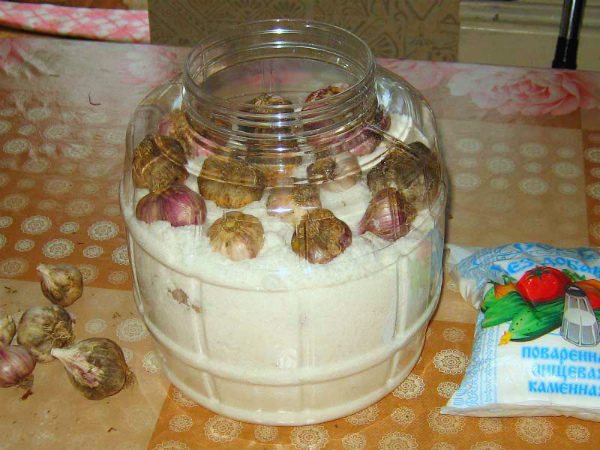

In a refrigerator
Can garlic be kept in the refrigerator? The refrigerator is a salvation in matters of food safety. Traditionally, housewives store pumpkin, broccoli, peppers, cauliflower and other vegetables in the refrigerator.
To keep garlic in the refrigerator you need:
- Dry the heads well.
- Put them in paper bags.
- Sprinkle with salt or onion skins if desired.
- Store in refrigerator separately from other vegetables.
Carrots can also be perfectly preserved in onion skins.
How to store garlic in the refrigerator in this video:
In salt
A way that many housewives love. To store garlic in salt, you need:
- Prepare the garlic for storage: sort, dry.
- Take boxes made of plywood.
- Pour salt into the bottom of the boxes.
- Lay out a row of garlic.
- Cover with salt.
- Lay out another row on top.
Such rows can be laid out up to 4-5 in one box. Garlic in salt keeps well in jars.
It is important to sprinkle the gaps between the heads well and make sure that they do not touch each other.
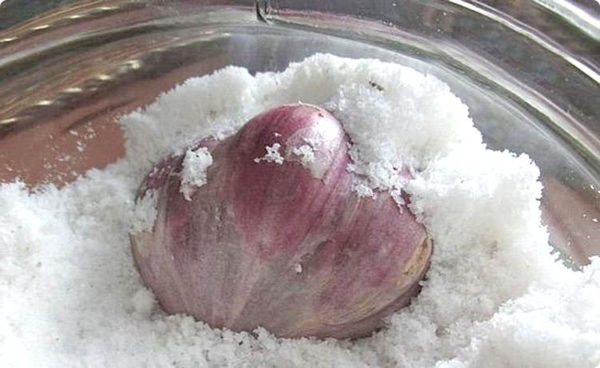

Twisted in a meat grinder
If the heads began to deteriorate, this storage method is used to save the entire crop. For this:
- They choose good cloves, discard the perishable slices.
- Peel the garlic.
- Grind with a meat grinder.
- Salted.
- They are put in jars.
- The jars are closed with plastic lids.
- Placed in a refrigerator.
This option is suitable not only in case of damage to the crop, but as one of many storage methods. If the crop is very rich, it is best to store some of the garlic. Also, such a garlic mass can be used for the emergency preservation of some products from spoilage, for example, in the country.
The disadvantage of this method is the short shelf life., but the advantage is that there is always a ready-made garlic mass at hand.


Purified
Peeled garlic should only be stored in the refrigerator. Just like that, in its natural state, it will not last long. To increase the shelf life of such garlic, it can be placed in a jar and filled with oil.
An alternative option is to store the peeled garlic in a sterilized jar. To do this, clean, dry cloves of garlic are placed in a pre-sterilized jar, covered with a plastic lid and placed in the refrigerator.


In oil
The advantage of this method is that in addition to the preservation of the garlic, the output is oil with a wonderful aroma.
The way is simple:
- Peel the cloves of garlic.
- Pour a little into the jar to taste: olive, sunflower, etc.
- Fold the garlic tightly into a jar of oil.
- Close the lid, put in the refrigerator.
This method can also be used to store green onions.
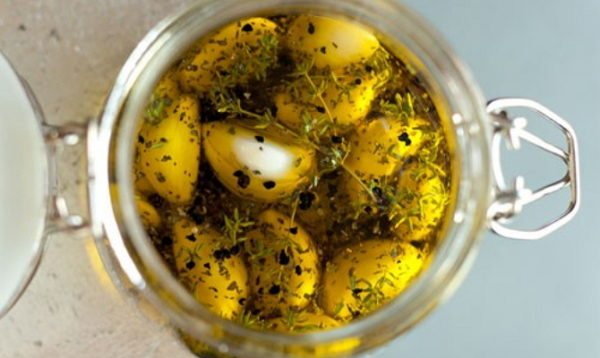

In fabric bags
Take rag bags that you can sew yourself from the remnants of unnecessary fabric. Dip the bags in strong saline solution... Then dry it. Put the heads of garlic in "salty" bags. Salt has impregnated the fabric, thereby creating an obstacle for pathogenic bacteria. The garlic will last a long time.
By the way, dried vegetables, such as broccoli or kale, can be stored in fabric bags.
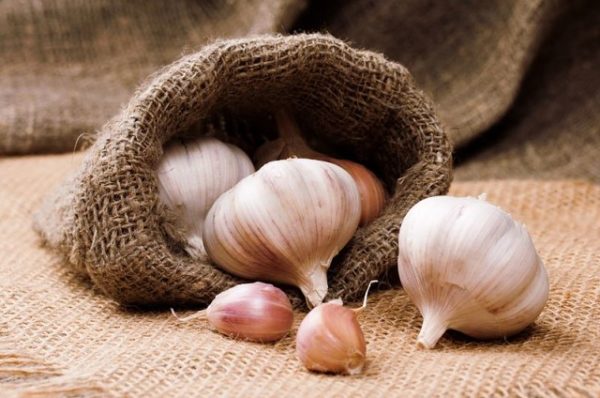

In paraffin
The method is unusual, but effective. Heads of garlic are dipped in molten paraffin... It envelops them and freezes. Garlic in a paraffin shell is stored for about six months. The same processing method is used for storing gladiolus bulbs.


In flour
Garlic is folded into three-liter jars with heads in the position in which they grew on the garden bed. Sprinkle each row of garlic with flour... Such jars are kept open in a cool place: refrigerator or on the balcony.


In sawdust
Instead of salt and flour, garlic is sprinkled with fresh sawdust, it is better if it is coniferous sawdust. At the same time, the garlic is folded into plywood boxes or boxes and stored in a dry, cool place. By the way, many housewives successfully store carrots in sawdust.


How to keep garlic at home until spring? 12 ways to store garlic in this video:
Signs of ripeness of garlic
The heads of garlic ripen fairly evenly. The main signs of the maturity of a vegetable:
- the lower leaves turn yellow;
- the teeth are easily separated;
- the tops begin to creep;
- the outer films have dried up and acquired a color characteristic of this variety;
- arrows straighten.
It is on these grounds that technical maturity is determined. This means that the complex bulb has formed, but the ripening process is still in its final stages and will end after harvest. Timely harvesting will ensure that the garlic is well stored.
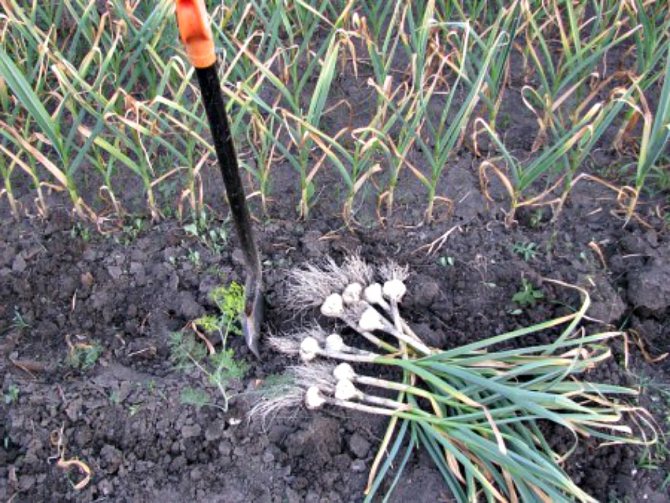

If the heads are cracked, then the teeth are ready to germinate, and, therefore, it is necessary to immediately start cleaning.
Benefit
Today this perennial plant of the genus onions is popular all over the world. The beneficial properties of garlic are due to the content in it of a rich set of organic and mineral compounds known to regulate many biochemical processes in the body.
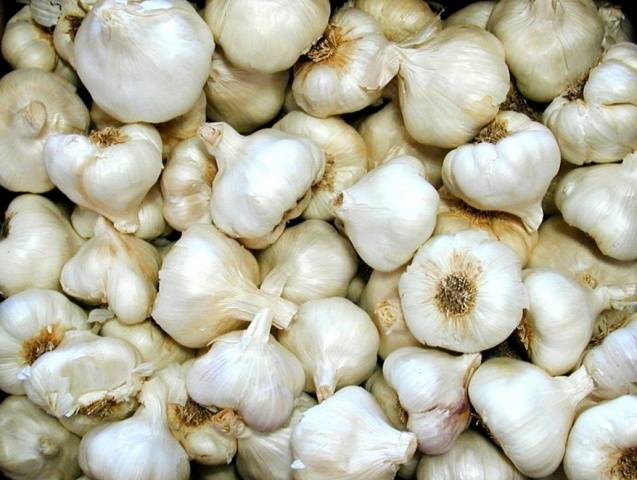

Some oriental treatment systems even classify garlic as a drug only:
- possessing antimicrobial and antibacterial properties, it strengthens the body's defenses in the fight against colds and infectious diseases;
- studies confirm the plant's ability to reduce the likelihood of atherosclerosis;
- with regular use, it increases immunity, reduces blood pressure, improves vascular elasticity;
- garlic has a beneficial effect on eyesight, skin condition, heart function, and is an excellent antioxidant.
However, you should not use the spice in large quantities for people with serious diseases such as hemorrhoids, asthma, hepatitis and some others.


Possible storage difficulties
Often it is not possible to track the storage conditions. In this case, the garlic may go bad. Problems include:
- Drying. When looking at stocks, you may find that some of the heads are dry, as if juice was squeezed out of them. This is due to the evaporation of moisture. To prevent the vegetable from drying, it is required to create a protective paraffin layer or tightly wrapping the head with cling film. High temperatures, direct sunlight are harmful. Humidity should be within normal limits.
- Damage to fungus, mold. The problem is associated with insufficient drying before storage or inattentive sorting. Mold and mildew can spread quickly. In this case, high-quality preparation of the crop is important. Proper drying will prevent the growth of fungi and bacteria.
- Germination. This is manifested by the rooting of garlic. To protect the hostess, the bottom is set on fire. This allows you to increase the shelf life and prevent germination. Sprouted garlic should be eaten first or peeled for storage in vegetable oil.
- Rot. The problem appears when there is insufficiently ventilated room with excessive moisture or when placing damaged heads. They are removed from the general container in order to exclude contamination of the rest of the vegetables. Garlic should be sorted and examined regularly. Drying before storage allows you to prevent rotting. In addition, garlic should not be next to other vegetables.


These mistakes can be avoided with proper preparation and storage. But if, nevertheless, they did arise, the situation should be corrected as soon as possible. This will preserve the rest of the garlic harvest.
Variants
How to prepare garlic for storage after harvesting? You must choose a storage method. Gardeners use several options:
- In braids. How to prepare garlic for storage for the winter, if this method is chosen? On dried bulbs, the stem should be cut and then the leaves removed. And the roots should be pruned. The stems must be collected in braids. Weaving twine or natural rope allows to provide strength. A loop is made at the end so that it is convenient to hang. Braids are left in basements, closets, in the pantry, in the hallway. Storage conditions for garlic in winter are dark and dry. Then vegetables will not lose their properties for a long time.
- Bunches. Storing garlic in this way in winter is also in demand due to the convenience of the method. After drying, the stem should be left up to 30 cm long. The bulbs are tied in bunches, leaving a loop for hanging. 15-25 bulbs should be combined in a bunch.
- In bags made of natural materials. Linen or cotton is highly breathable. Small bags should be filled with onions, then tied and hung. To ensure the safety of the bag, immersion in a strong solution of sodium chloride (1 liter and 3-5 tbsp) allows. The product is removed, the solution is allowed to drain and dry, and then filled with garlic.
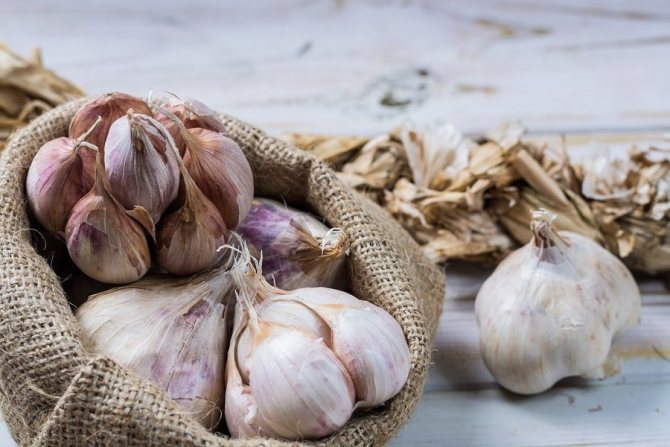

These are popular ways to preserve a vegetable. Thanks to their use, there will always be a natural and high-quality vegetable at home.
Preparation
How to prepare garlic for long-term storage? Preparation begins from the moment of harvest.
There are 2 types of garlic, the timing and features of collection depend on them:
- spring - a variety also referred to as summer garlic.They are harvested when its leaves turn very yellow and begin to bend down and lie on the ground. Harvesting time within early to mid-August;
- winter or winter - harvested at the end of July. You can determine readiness by several signs: yellowing of leaves, thinning of scales, cracks in the skin of inflorescences.
When digging up garlic, it is important not to damage it, since damaged heads are not suitable for long-term storage. It is better to remove it with a shovel or pitchfork. Then the garlic must be thoroughly dried in the open sun or under a canopy.
Depending on the method chosen, cut off the stems (except for storage in braids). Its preservation for a long time depends on the correct sorting of garlic.
Can't be left:
- empty heads;
- affected by rot or other diseases;
- scratched, damaged, peeled off.
After all the preparatory procedures have been completed, it's time to move on to choosing a storage method.
Do not be discouraged if some of the garlic is not suitable for long-term storage, the substandard can be dried and used as a seasoning in this form, or it can be frozen - this is another good way of long-term storage that should not be neglected.
Every housewife knows that you can successfully freeze foods such as zucchini, pumpkin, bell peppers, carrots and onions, and this also applies to garlic.
You can learn how to properly dig up and prepare garlic for storage in this video:
How to store garlic at home for the winter?
If you collect it in time, you will keep it for a long time.


One of the main secrets of successful storage of garlic stocks is the correct timing of harvesting a vegetable. Winter crops are dug up in the middle of summer, spring crops - in late August or early September.
The exact dates are determined:
- features of the variety;
- climatic conditions.
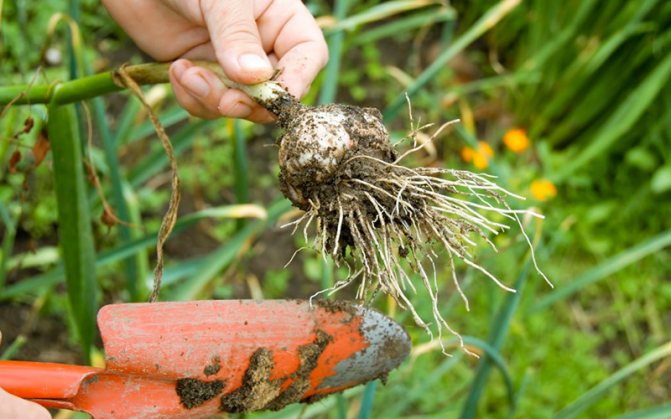

On a note! It is impossible to say exactly the date of the harvest. Experienced gardeners take into account a complex of factors, including their own experience.
Maturity is determined by the onset of lodging and yellowing of the leaf plates, thinning of the integumentary scales on the head. In shooting varieties, several peduncles are left, which will "prompt" about the ripening of the vegetable. The shell of the inflorescences begins to dry out and burst, and this is a sure signal to dig up the garlic.
Immature heads are poorly stored, often moldy and deteriorate. Overripe crumble into teeth, crack, dry up and are also not suitable for pantries. Therefore, it is important to try to determine the exact time of collection and not be late.
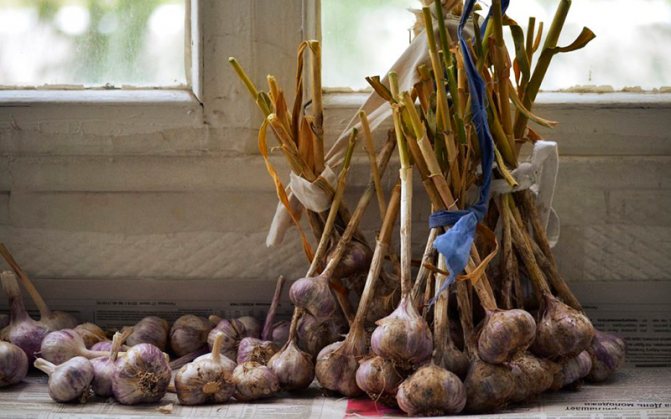

The harvested garlic is dried by sprinkling it in a single layer on tables under awnings in the attic. It is advisable to dry for at least 10-12 days at a temperature of +20 ºC… + 23 ºC, and only then cut off the stems. Covering dry scales are not removed, the roots are cut off after complete drying.
If you plan to tie the heads in "braids", then the tops are left long. In all other cases, cut to 6-10 cm. The long stem does not allow the onions to dry out, and the integumentary scales remain intact, not deformed.
How to store peeled garlic?
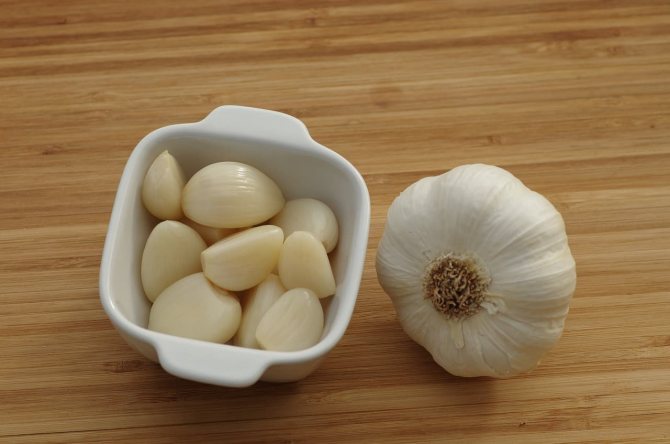

Peeled garlic
You can store peeled garlic as follows:
- in the refrigerator (freezer);
- in pickled form (brine or vegetable oil);
- in flour or salt.
Whichever method you choose, you need to adhere to a number of rules. They are simple, but will allow you to preserve the vegetable for a longer time.
- Select only healthy, cleaned and dried cloves for storage.
- Inspect regularly.
- Do not re-freeze.
Cleaning garlic from the site
Check out these articles as well
- Blueberry feeding
- Perennial rudbeckia flower
- Picking tomato seedlings
- Why do geranium leaves turn yellow
The shelf life of garlic directly depends on the characteristics of the harvest. If the rules are disregarded during the collection of garlic, the crop can quickly deteriorate.
Harvesting is carried out after the garlic has probably ripened, you should not dig it out ahead of time. Cleaning time - dry, sunny or cloudy day. The main thing is that the ground is not wet, and rain is not foretold. The easiest way to dig out the garlic is with a pitchfork or a shovel, because it does not always break out easily from the ground, if you pull too hard, you can damage the head.
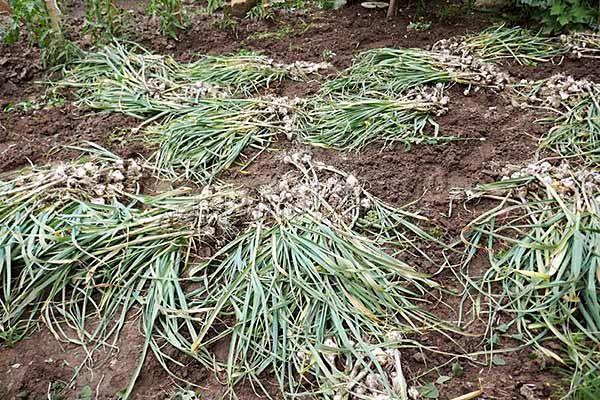

The main thing is that during the harvesting of garlic the earth is not wet and rain is not foreshadowed.
Garlic is taken out of the ground, holding by the tops, and laid out to dry on the site itself or under the roof. It is best to dry the garlic in the sun, before storing the garlic, then the keeping quality of the heads will be greater. After the garlic has dried for 1-2 weeks, it can be prepared for storage.
Important!
Garlic has a dense structure. But, despite this, during harvesting, you cannot throw it on the ground or when laying it in a container. This can lead to the appearance of dents on the teeth and they will eventually start to rot or become a habitat for fungi and pests.
Which garlic is best stored - spring or winter?
Do spring and winter garlic differ in keeping quality? There is an opinion that spring is stored better, and there is a completely logical explanation for this. The heads planted in early spring have time to build up a dense skin. Winter varieties are harvested in summer, they are covered with thin husks, and during storage, the cloves release arrows, become soft and unappetizing.
What are the reasons for drying out and deterioration during storage?
- The defeat of fungal diseases. It is important to observe crop rotation, decontaminate the planting material, as well as the soil before planting.
- The variety is not designed for long-term storage.
- Conditions are not suitable - too high humidity and temperature.
